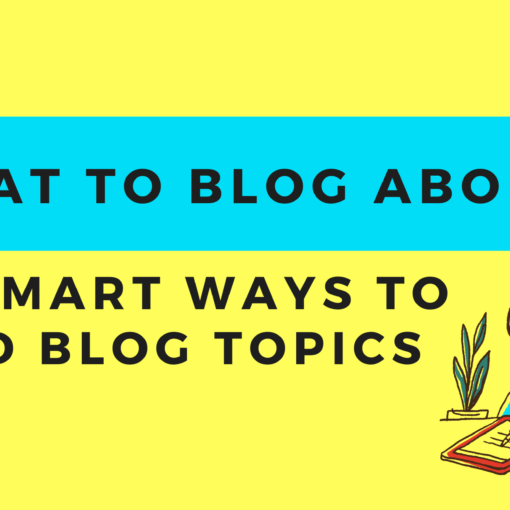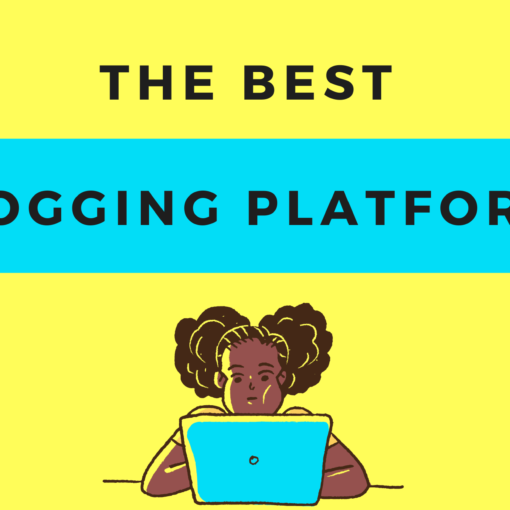If you have a company, whether it’s product or service-based, you need to invest in blogging to drive growth.
You don’t have to be a writer to start or run a blog, you just have to be passionate about your business, your brand, and helping your audience. Not sure what to blog about, or struggling to come up with blog post ideas? Wondering why you even need to have a blog?
This post will explain the benefits of blogging, how to create a blog, and provide you with lots of tips, ideas, and examples, about how you can blog effectively for your business.
CONTENTS
- Why Blogging is Important for Your Business
- How to Create a Business Blog
- Business Blog Writing Tips
- Blog Ideas for Businesses
- Business Blog Examples
- How Often Should a Business Blog?
- Tips for Growing Your Blog
Why Blogging is Important for Your Business
In order to understand why blogging could be good for your business, you need to look at your business goals, and then determine if and how blogging can help.
Two of the most important aspects of growing a business are getting more customers and building a strong brand. These objectives are codependent, and blogging contributes to achieving both of them. Here’s how:
Builds Brand Awareness
When a business goes beyond just selling and focuses on providing value through content marketing, it drives more audience engagement. Website visitors share blog posts and talk about them on social media or online communities, all of which lead to greater brand awareness for your business.
Increases Trust
Studies show that 52% of B2B buyers are more likely to buy from a vendor after reading its content. And 30% consume content even before they speak to a salesperson.
Establishes Expertise
The purpose of a blog is to provide information about topics related to the industry the business is in, and the company’s specific niche. It can include in-depth information about its products and services, as well as helpful tips that provide real value to the audience even if they’re not customers yet.
As such, it establishes the expertise and authority of the company.
Boosts SEO And Drives Website Traffic
A company that blogs gets 55% more website visitors than those that don’t. They also have 434% more indexed pages and are likely to have 2X more email traffic.
So if you want more eyes on your website, not to mention greater audience engagement, you have to have a blog for your business.
Generates More Leads
Companies with blogs generate 67% more leads than businesses that don’t.
So if you want to grow your business, blogging is a no-brainer!
How to Create a Business Blog
If you are just about to set up your business blog, the best way to do that is to create a clean and smooth site structure that showcases your blog along with your products and pages. Here are some tips:
Step 1. Add Your Business Blog
Unless there is a specific reason for not doing so, you should include your blog in your business domain so your audience has all the information in one place.
Most content management systems include a blog feature, which is a section of the site to specifically set up for your blog posts.
One key point to remember is that if you’re not a giant website with hundreds of pages, you should consider having your blog in a subfolder (in the format of https://domain.com/blog/), rather than a subdomain (https://blog.domain.com).
A subfolder enjoys all the SEO benefits of the domain, whereas a subdomain is like a separate domain that will need its own SEO.
Step 2. Create Blog Categories
On any website, especially a business website, information should be easy to find and browse through. So, create a good site structure with categories and subcategories if needed.
Avoid putting your blog posts directly under your homepage thinking it will drive more traffic. Creating a clear ‘blog’ section with categories is much better for both user experience and SEO.
Step 3. Develop a Business Blogging Strategy
If you have a personal blog that’s just for fun, you can write whatever or whenever you want.
But as a business, you will have to commit some resources to your blog So make sure it’s worth the investment. Create a content strategy before you even write your first post.
Key elements to include in your strategy:
- Your goals and objectives – E.g. get more website traffic, build a brand presence, generate leads.
- Content ideas for each stage of the customer journey – E.g. some types of content work better for generating leads, others for driving conversions, and so on.
- Define the metrics and tools to measure your blogging ROI – E.g. goal conversions in Google Analytics, keywords you hope to rank for.
Business Blog Writing Tips
Whenever you write a blog post, you need to do the following:
1. Keep Your Buyer Persona(s) in Mind
Remember that you’re not writing blog posts for yourself or your business. You’re writing them for your audience, which includes your current and potential buyers. Create a buyer persona before you start your content marketing. Make sure each of your posts solves a problem or addresses some need or desire of that persona.
2. Write High-Quality Content
Once upon a time, long, long, ago, you could rank on Google and build brand loyalty using 400-word posts. Now, you must ensure each blog post covers a topic in sufficient depth and provides immense value to your audience. Generally this is reflected in the word count as longer posts equal greater depth.
3. Create Content that Reflects Your Brand
When you launch a business, you also have to define your branding, which includes aspects such as your: :
- Unique value proposition
- Tone of voice
- Colors
- Communication style
- Personality
Make sure your business blog upholds all these elements consistently. For example, if you have decided your brand personality and communication style should have a sense of humor, retain that in your blog posts, too.
4. Post Regularly
However you have set out your blogging schedule in your content strategy (more on this below), just stick to it. Don’t fall off the grid after writing a few posts. Remember that blogging is a means of communicating and engaging with your audience as well. So keep it consistent and you will stay fresh in their minds.
5. Optimize Your Blog for SEO
Make sure your blog posts are optimized for the search engines, to help you rank for your audience’s search queries. Work on the 6 elements of SEO:
- Keyword Research
- Technical SEO
- On-page SEO
- Content SEO
- Off-page SEO
- Local SEO
6. Provide a Good User Experience on Your Blog
Keep your blog clean and easy to read. Generally, you can have two types of blog layouts:
Left-Aligned Blog Layout, With Sidebar
This layout allows you to place your strategic calls to action on the right. This could include your latest blog posts, your services, or your lead magnets. Then, if readers are interested, they can check out these conversion-driven pages at any time.
Centered Blog Layout, Without Sidebar
In this layout, your content is in the middle of the page, with no distractions on either side.
Moreover, when people come to read your blog the user experience should be fantastic. Include images to highlight your points and break up the text into smaller pieces. Make the text easy to read, add lots of white space.
Blog Ideas for Businesses
If you’re wondering what to write about on your business blog, there are various types of posts to consider. Some of these could be:
- Industry trends
- Case studies
- Research your business has conducted
- Product/service tutorials
- Behind-the-scenes peeks
- Expert interviews
- Tips to solve a problem or attain a goal
- Guides and how-to posts
- Stories from users on how they use your product/service (user-generated content)
Business Blog Examples
Wondering how to start? Looking for inspiration as to what kind of a blog you want your business to have? Here are some examples of business blogs that have established a strong brand for themselves and attract thousands of visitors every month.
Backlinko
Owned by Brian Dean, Backlinko’s value proposition revolves around one single topic: Search Engine Optimization. Brian writes extremely in-depth content and provides lots of examples and data.
Below is an example of a case study that he wrote on content marketing. Just look at the number of shares he got!
Over time, Brian has established himself as a go-to SEO, just through his blog posts.
And you could do the same! Get your blog off to an epic start by checking out the Copy Goals guide to the best blogging platforms.
Culture Trip
Culture Trip is a travel e-commerce website that helps you to book your holidays. Its blog is full of comprehensive information about different cities in the world. All the posts are grouped to form travel guides.
Here’s an example of how they did this for Siem Reap in Cambodia:
There are different sections within each travel guide, like See & Do, Food & Drink, Art, etc.
None of these posts are about selling a product or even their booking services. They simply provide value so you refer to them repeatedly for the information you need about the city you’re traveling to.
As time goes on, readers start trusting the company thanks to their useful blog posts. It’s only natural then that when it comes to booking a stay, they would feel good about doing it with this brand.
Patagonia
Patagonia is an outdoor clothing and sports gear line. They encourage user-generated content, and instead of a typical blog section, they have ‘Stories’. These usually include beautiful pictures and, occasionally, videos.
Again, the stories are not about specific products. They simply reinforce the brand’s position as an outdoor brand. The stories hook the reader and build emotional connections. Not everyone will engage with this type of content, sure, but the brand’s audience will.
If you’re just starting out, don’t get overwhelmed by these content examples. They are just to show you that there are various ways of writing blogs that can help you grow your brand and business.
The types of blog posts you write, as mentioned earlier, really depend on your niche, your specific audience, and your unique value proposition.
How Often Should a Business Blog?
Some businesses choose to have one long-form piece of content (5000+ words) every month, whereas some add a 1000+ word post every week or two weeks.
The frequency of your blog posts depends on your content marketing strategy. But here are a couple of factors to consider:
- Your SMART Goals
How much you blog depends on how much you want to achieve, and by when. The more you blog, the faster you will improve your SEO and get more traffic. Big businesses can publish multiple posts a week, whereas a single blogger may write only one post a month.
- Your Resources
If you’re a solo entrepreneur or have a small team running the business, don’t stress yourself out trying to blog too often.
What’s more important is that your posts are of a high quality, provide real value to your audience and that your audience can find that content through different channels.
Tips for Growing Your Blog
Once you’ve established your blog, you may be wondering what comes next. Here are some final tips to make your blog thrive:
1. Promote Your Blog Posts Relentlessly
I don’t mean you should SPAM people with your blog posts. However, the biggest challenge faced by blogs in the beginning is exposure. You may have a fantastic piece of content on your blog, but if no one sees it, reads it, or shares it, it wasn’t worth the effort.
So share it on social media multiple times to ensure that more people can see it on their feeds. To keep your posts fresh, vary the descriptions, the images, maybe ask questions.
Share it again next month, and the month after that.
2. Build Relationships, Respond to Comments
If someone bothers to write a comment on your post, good or bad, respond to them. Remember a big goal of content marketing is to drive engagement with your audience. So, build up conversations and relationships with them, earn their trust and loyalty. People buy from those they trust.
3. Create a Lead Generation/Nurturing Campaign, Add Calls to Action
Encourage the reader gently to take action after reading your blog posts. You could simply ask them to sign up for your newsletter so you can send them useful tips or information. Other ways to get their email could be to ask them to:
- Download a free report
- Register for a webinar
- Participate in a contest or quiz
- Leave a comment on your blog
The goal is simply to have permission to send them emails, through which you can nurture their needs for some time before you try to sell anything.
4. Track Your Content Performance
Remember you defined metrics with which to measure your blogging efforts? Keep analyzing your data regularly. This will help you understand what’s working and what’s not, so you can revise your strategy accordingly.
It would be great to hear your comments on blogging for business! Which of these tips helped you the most? Did I miss any or would you like to add some blogging strategies that work well for your business?



One thought on “The Beginner’s Guide to Blogging for Business”
Hey
Your post is very helpful and informative. First thing that is passionate about our business is very important.
fantastic piece of content is very important for blog.Keep analyzing data regularly that will help us to understand what’s working and what’s not.
Your all tips are very good and effective.
Thank you
Sweety